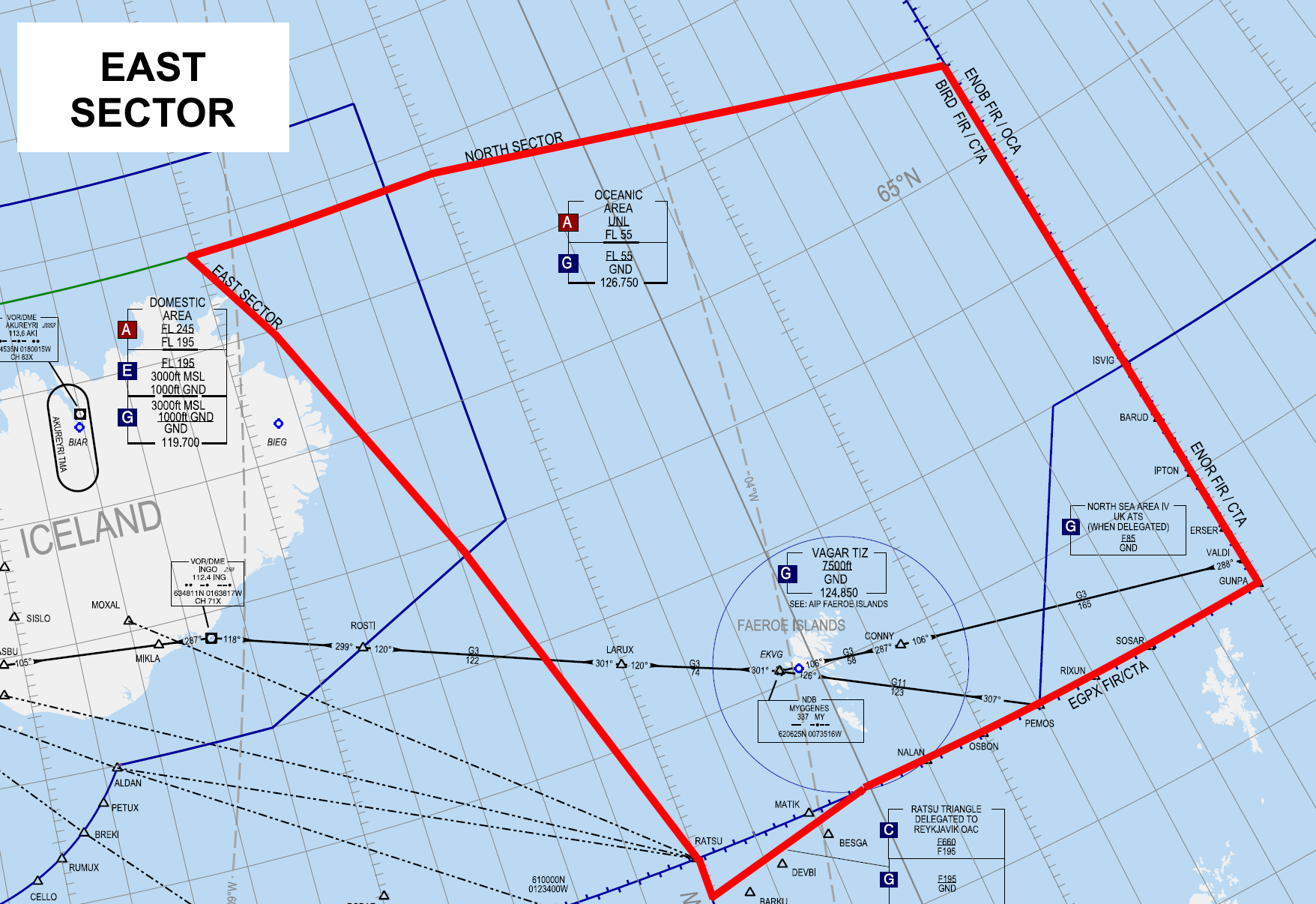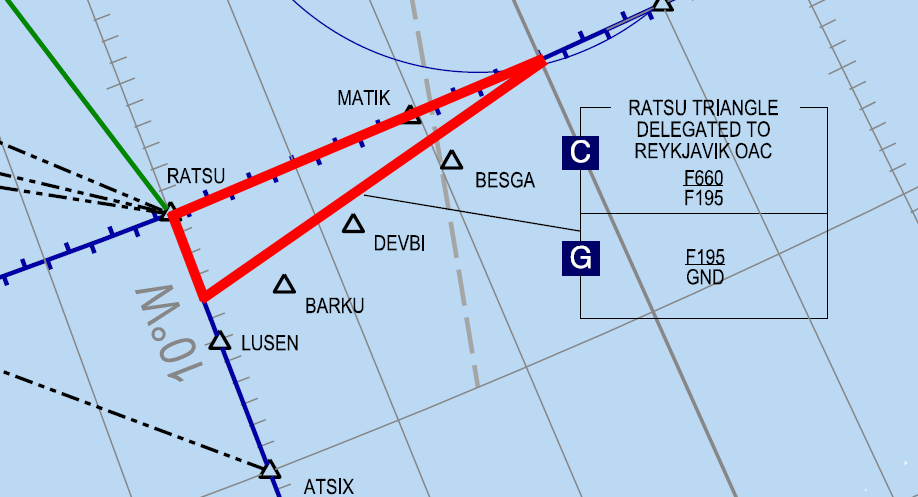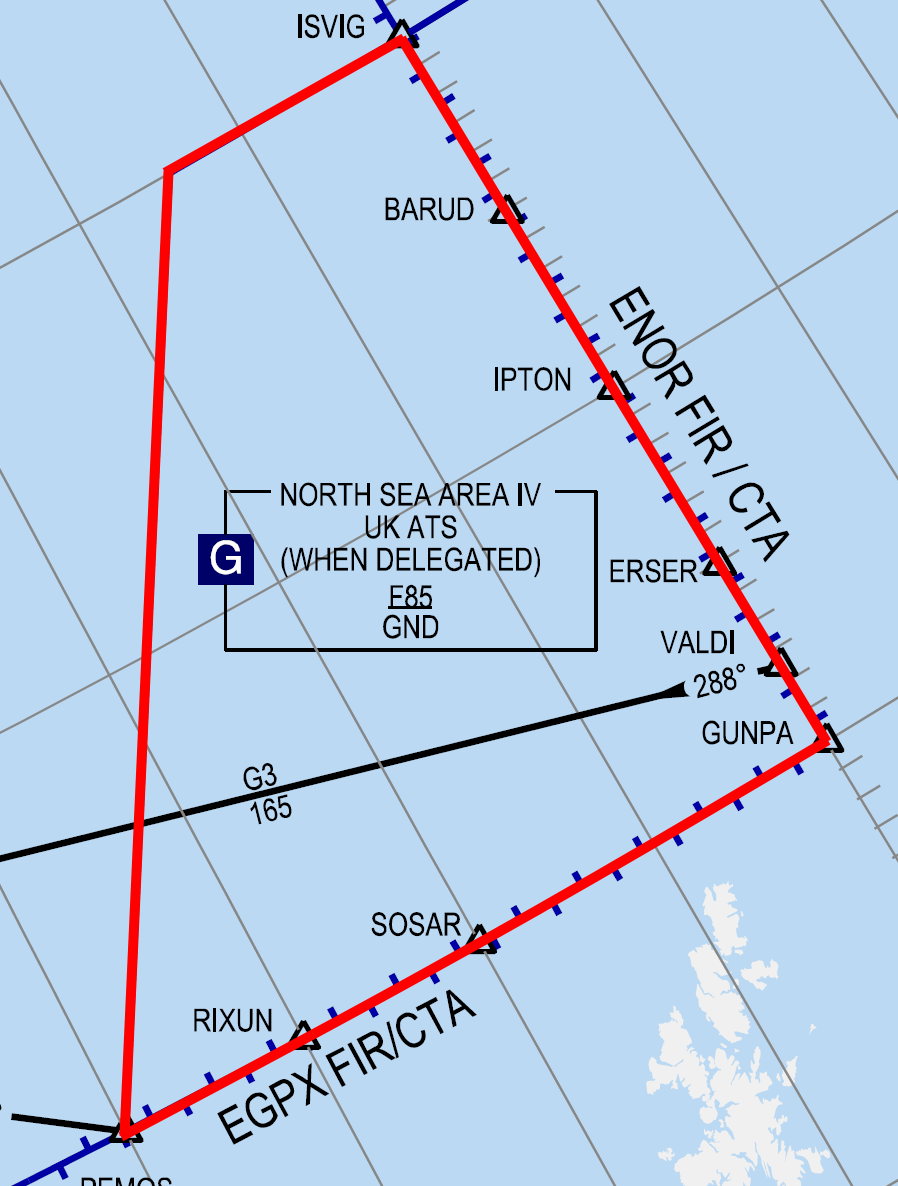East Sector
The East sector overlies the Faroe Islands, and contains a small portion of the Icelandic Domestic Area.
It is bordered by Scottish FIR (EGPX), Stavanger ACC (ENSV) of Polaris FIR, and Bodo OFIR (Oceanic FIR). It also shares a small border (on the Westernmost side of the RATSU Triangle) with Shanwick OCA (EGGX).
Airspace Classification
Excluding the Vagar FIZ, the East sector is:
- Class A from FL195+ within the lateral boundaries of the Domestic Area, and FL55+ elsewhere.
- Class E from 3000ft – FL195 within the boundaries of the Domestic Area.
- Class G from GND – 3000ft within the lateral boundaries of the Domestic Area, and GND – FL55 elsewhere.
List of ATS Positions
|
East 1 (E1) |
BIRD_E1_CTR |
Reykjavik Control |
126.750 |
|
East 2 (E2) |
BIRD_E2_CTR |
132.200 |
|
|
East 3 (E3) |
BIRD_E3_CTR |
128.800 |
|
|
South 1 (S1) Only if no East sector online |
BIRD_S1_CTR |
119.700 |
|
|
South 2 (S2) Only if no East sector online |
BIRD_S2_CTR |
125.700 |
|
|
South 3 (S3) Only if no East sector online |
BIRD_S3_CTR |
128.600 |
|
|
Radio 1 (CC1) RCL ONLY |
BICC_1_FSS |
Iceland Radio |
127.850 |
Underlying Aerodromes
AFIS
EKVG
Delegated Airspace
RATSU Triangle
The RATSU Triangle (GND – FL660) is located at the southwest corner of the East sector. It is delegated from Scottish (EGPX) FIR to Reykjavik Control. It is classified:
- Class C from FL195 – FL660
- Class G from GND – FL195
See BIRD-EGPX LOA for more information.
North Sea Area IV
North Sea Area IV (GND – FL85), or simply "Area IV," is located at the southeast corner of the East sector. It is delegated from Reykjavik Control to Sumburgh Radar (Prestwick ACC) in Scotland. It is Class G. See BIRD-EGPX LOA for more information.
Oceanic Entry (RCL)
Airborne aircraft entering the East sector from domestic airspace (or from oceanic airspace with offline ATC) shall transmit their RCL message to the following positions, in order of priority:
- Radio 1 (BICC_1_FSS)
- The East sector whose level the aircraft will be entering (or South sector bandboxing East, if no East sectors are online.)
- E.g., if East 1 & East 3 are online, splitting the East sector at FL355, an inbound aircraft at FL365 would receive OCL from East 3.
- E.g., if East 1 & East 3 are online, splitting the East sector at FL355, an inbound aircraft at FL365 would receive OCL from East 3.
Procedures
To/From EKVG
If the local AFIS unit is offline, the lowest East sector provides top-down AFIS for EKVG.
For arrivals, Reykjavik Control shall descend aircraft to the Transition Level (TL) for EKVG, then clear the aircraft to descend below controlled airspace. Reykjavik Control shall not clear aircraft onto any instrument procedures, as the procedures are entirely within uncontrolled airspace.
Reykjavik Control may ask aircraft what their intended approach is, and share this information with Vagar AFIS as appropriate.
For departures, Reykjavik Control shall clear aircraft onto the SIDs, as they enter controlled airspace.
Neighboring Sectors Without LOAs
In lieu of official LOAs regarding the sectors below, note the following information.
NOTE! The information below is provided for reference only, and is not a substitute for proper coordination with these sectors in the absence of an LOA.
EGGX (Shanwick)
NAT_FSS is the bandbox position for Gander & Shanwick OCAs.
- When transferring aircraft to NAT_FSS that are entering Shanwick OCA, the appropriate radio callsign is “Shanwick Radio” (i.e., “contact Shanwick Radio on…”)
In real life, Reykjavik Control passes to Shanwick Radio (by coordination) a squawk code for all aircraft entering Reykjavik OCA from Shanwick OCA. The intention is that the aircraft are squawking the Reykjavik-assigned code by the time they enter the Reykjavik OCA.
As this is not formally defined in an LOA, not all Shanwick/NAT controllers will be aware of this procedure. Therefore, this procedure should only be adopted if mutually coordinated/agreed by both Shanwick & Reykjavik controllers.



